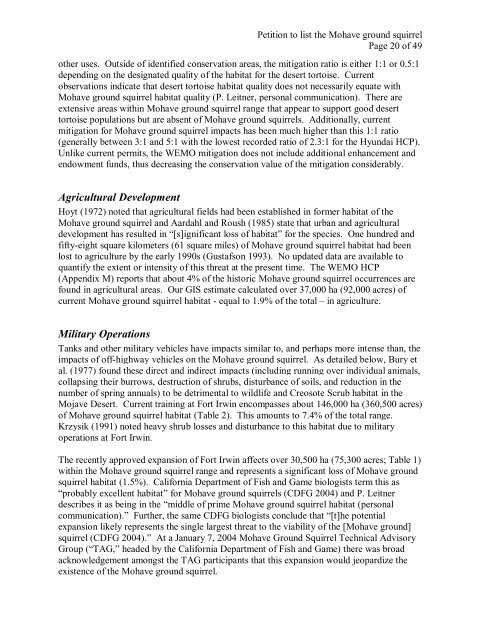Petition to list the Mohave Ground Squirrel - Defenders of Wildlife
Petition to list the Mohave Ground Squirrel - Defenders of Wildlife
Petition to list the Mohave Ground Squirrel - Defenders of Wildlife
You also want an ePaper? Increase the reach of your titles
YUMPU automatically turns print PDFs into web optimized ePapers that Google loves.
<strong>Petition</strong> <strong>to</strong> <strong>list</strong> <strong>the</strong> <strong>Mohave</strong> ground squirrel<br />
Page 20 <strong>of</strong> 49<br />
o<strong>the</strong>r uses. Outside <strong>of</strong> identified conservation areas, <strong>the</strong> mitigation ratio is ei<strong>the</strong>r 1:1 or 0.5:1<br />
depending on <strong>the</strong> designated quality <strong>of</strong> <strong>the</strong> habitat for <strong>the</strong> desert <strong>to</strong>r<strong>to</strong>ise. Current<br />
observations indicate that desert <strong>to</strong>r<strong>to</strong>ise habitat quality does not necessarily equate with<br />
<strong>Mohave</strong> ground squirrel habitat quality (P. Leitner, personal communication). There are<br />
extensive areas within <strong>Mohave</strong> ground squirrel range that appear <strong>to</strong> support good desert<br />
<strong>to</strong>r<strong>to</strong>ise populations but are absent <strong>of</strong> <strong>Mohave</strong> ground squirrels. Additionally, current<br />
mitigation for <strong>Mohave</strong> ground squirrel impacts has been much higher than this 1:1 ratio<br />
(generally between 3:1 and 5:1 with <strong>the</strong> lowest recorded ratio <strong>of</strong> 2.3:1 for <strong>the</strong> Hyundai HCP).<br />
Unlike current permits, <strong>the</strong> WEMO mitigation does not include additional enhancement and<br />
endowment funds, thus decreasing <strong>the</strong> conservation value <strong>of</strong> <strong>the</strong> mitigation considerably.<br />
Agricultural Development<br />
Hoyt (1972) noted that agricultural fields had been established in former habitat <strong>of</strong> <strong>the</strong><br />
<strong>Mohave</strong> ground squirrel and Aardahl and Roush (1985) state that urban and agricultural<br />
development has resulted in “[s]ignificant loss <strong>of</strong> habitat” for <strong>the</strong> species. One hundred and<br />
fifty-eight square kilometers (61 square miles) <strong>of</strong> <strong>Mohave</strong> ground squirrel habitat had been<br />
lost <strong>to</strong> agriculture by <strong>the</strong> early 1990s (Gustafson 1993). No updated data are available <strong>to</strong><br />
quantify <strong>the</strong> extent or intensity <strong>of</strong> this threat at <strong>the</strong> present time. The WEMO HCP<br />
(Appendix M) reports that about 4% <strong>of</strong> <strong>the</strong> his<strong>to</strong>ric <strong>Mohave</strong> ground squirrel occurrences are<br />
found in agricultural areas. Our GIS estimate calculated over 37,000 ha (92,000 acres) <strong>of</strong><br />
current <strong>Mohave</strong> ground squirrel habitat - equal <strong>to</strong> 1.9% <strong>of</strong> <strong>the</strong> <strong>to</strong>tal – in agriculture.<br />
Military Operations<br />
Tanks and o<strong>the</strong>r military vehicles have impacts similar <strong>to</strong>, and perhaps more intense than, <strong>the</strong><br />
impacts <strong>of</strong> <strong>of</strong>f-highway vehicles on <strong>the</strong> <strong>Mohave</strong> ground squirrel. As detailed below, Bury et<br />
al. (1977) found <strong>the</strong>se direct and indirect impacts (including running over individual animals,<br />
collapsing <strong>the</strong>ir burrows, destruction <strong>of</strong> shrubs, disturbance <strong>of</strong> soils, and reduction in <strong>the</strong><br />
number <strong>of</strong> spring annuals) <strong>to</strong> be detrimental <strong>to</strong> wildlife and Creosote Scrub habitat in <strong>the</strong><br />
Mojave Desert. Current training at Fort Irwin encompasses about 146,000 ha (360,500 acres)<br />
<strong>of</strong> <strong>Mohave</strong> ground squirrel habitat (Table 2). This amounts <strong>to</strong> 7.4% <strong>of</strong> <strong>the</strong> <strong>to</strong>tal range.<br />
Krzysik (1991) noted heavy shrub losses and disturbance <strong>to</strong> this habitat due <strong>to</strong> military<br />
operations at Fort Irwin.<br />
The recently approved expansion <strong>of</strong> Fort Irwin affects over 30,500 ha (75,300 acres; Table 1)<br />
within <strong>the</strong> <strong>Mohave</strong> ground squirrel range and represents a significant loss <strong>of</strong> <strong>Mohave</strong> ground<br />
squirrel habitat (1.5%). California Department <strong>of</strong> Fish and Game biologists term this as<br />
“probably excellent habitat” for <strong>Mohave</strong> ground squirrels (CDFG 2004) and P. Leitner<br />
describes it as being in <strong>the</strong> “middle <strong>of</strong> prime <strong>Mohave</strong> ground squirrel habitat (personal<br />
communication).” Fur<strong>the</strong>r, <strong>the</strong> same CDFG biologists conclude that “[t]he potential<br />
expansion likely represents <strong>the</strong> single largest threat <strong>to</strong> <strong>the</strong> viability <strong>of</strong> <strong>the</strong> [<strong>Mohave</strong> ground]<br />
squirrel (CDFG 2004).” At a January 7, 2004 <strong>Mohave</strong> <strong>Ground</strong> <strong>Squirrel</strong> Technical Advisory<br />
Group (“TAG,” headed by <strong>the</strong> California Department <strong>of</strong> Fish and Game) <strong>the</strong>re was broad<br />
acknowledgement amongst <strong>the</strong> TAG participants that this expansion would jeopardize <strong>the</strong><br />
existence <strong>of</strong> <strong>the</strong> <strong>Mohave</strong> ground squirrel.
















